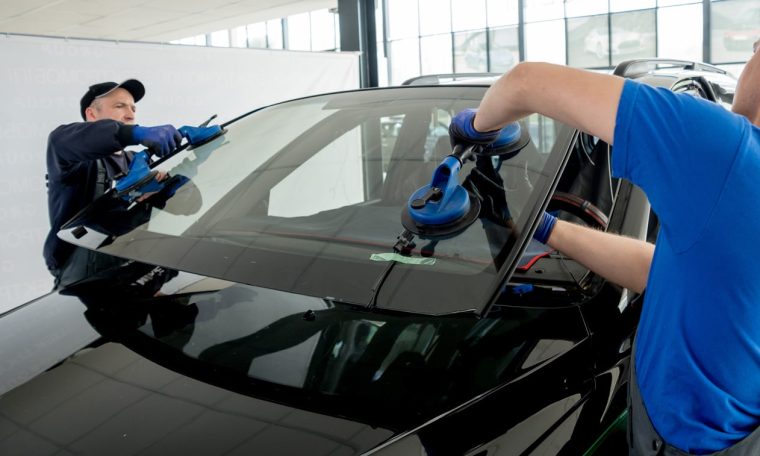
Windshields play a crucial role in the structural integrity of a vehicle, providing not only protection from the elements but also contributing to the overall safety of the occupants. Unfortunately, wear and tear, accidents or weather-related incidents can lead to the need for a windshield replacement. In this guide, we’ll walk you through the process of removing and installing a new windshield, empowering you to take on this task yourself.
Assessing the Damage
Before diving into the replacement process, it’s essential to assess the damage accurately. Small chips or cracks might be repairable, but extensive damage may necessitate a full windshield replacement. Understanding the severity of the damage guides your decision-making process.
One of the critical steps in the windshield replacement process is accurately assessing the extent of the damage. The condition of your windshield determines whether a repair or install a new windshield. Here’s a closer look at how to assess the damage:
1. Inspect the Type of Damage:
- Start by examining the type of damage your windshield has incurred. Is it a small chip, a crack, or a combination of both? Different types of damage may require different approaches.
2. Consider the Size and Location:
- Size matters when it comes to windshield damage. Small chips can often be repaired, while larger ones or extensive cracks might necessitate a complete replacement. Additionally, the location of the damage plays a role; damage near the edges can compromise structural integrity.
3. Evaluate the Depth:
- Check the depth of the damage. Surface-level scratches may be repairable, but if the damage extends through the layers of the windshield, replacement is likely the safer option.
4. Assess the Impact on Driver’s Visibility:
- Consider how the damage affects your visibility while driving. Even minor damage that impairs your line of sight can compromise safety and calls for prompt attention.
5. Check for Spiderweb Cracks:
- Spiderweb cracks, where smaller cracks radiate from a central point, are a sign of significant impact. If your windshield displays this pattern, replacement is usually the recommended course of action.
6. Look for Contamination:
- Inspect for any contamination within the damaged area. If dirt, water, or debris has penetrated the crack or chip, it may hinder the effectiveness of repairs.
Safety Precautions
Your safety is paramount during windshield replacement. Ensure you have the necessary safety gear, including gloves and eyewear. Additionally, take the time to prepare your vehicle properly, disconnect the battery, and securing loose items.
Removing the Old Windshield
- Remove Wipers and Trim: Begin by removing the windshield wipers and any surrounding trim.
- Cut the Sealant: Use a utility knife to cut through the sealant holding the windshield in place.
- Detach the Windshield: With the help of glass suction cups, carefully detach the windshield from the frame.
Preparing for Installation
- Clean and Prime: Thoroughly clean the windshield frame and apply a primer to ensure proper adhesion.
- Select the Right Windshield: Choose a replacement windshield that matches your vehicle’s make and model.
Installing the New Windshield
- Align and Secure: Carefully align the new windshield with the frame, ensuring a snug fit.
- Secure in Place: Use a caulking gun to apply adhesive/sealant and secure the windshield in place.
Final Checks and Clean-Up
- Verify the Installation: Check for proper alignment and secure attachment.
- Clean Excess Material: Remove any excess adhesive or sealant for a clean finish.
Post-Installation Care
- Allow for Curing: Be patient and allow sufficient time for the adhesive to cure.
- Handle with Care: Avoid slamming doors or driving on rough terrain immediately after installation.
Benefits of DIY Windshield Replacement
Taking on the task of windshield replacement yourself comes with several advantages. Not only does it save you money, but it also provides a sense of accomplishment in successfully completing a significant automotive repair.
Common Mistakes to Avoid
- Rushing the removal process
- Neglecting to prime the windshield frame
- Choosing the wrong adhesive/sealant
Professional vs. DIY
While DIY is a viable option for many, there are instances where professional help is advisable. Professionals bring experience and efficiency to the table, especially in complex installations or for individuals lacking confidence in their skills.
Environmental Impact
Consider the environmental impact of windshield replacement. Many auto glass shops recycle old windshields, contributing to sustainable practices. Research eco-friendly options for disposal in your area.
Can I replace a windshield on my own?
Yes, with the right tools and precautions, replacing a windshield can be a DIY task.
How long does it take to replace a windshield?
The process typically takes a few hours, considering the curing time for adhesives.
What materials are needed for windshield replacement?
Tools like a screwdriver and utility knife, along with a replacement windshield and adhesive.
Are there any risks in DIY windshield replacement?
While DIY is feasible, improper installation can lead to leaks or structural issues. Follow instructions carefully.
Can I drive immediately after a windshield installation?
It’s advisable to wait for the recommended curing time before driving to ensure a secure bond.
Conclusion
By following this guide, you’ve empowered yourself to tackle the task of removing and installing a new windshield. Whether you choose to go the DIY route or seek professional help, prioritizing safety and precision ensures a successful outcome. Enjoy the clarity and safety of your new windshield!
In conclusion, mastering the art of removing and installing a new windshield is a valuable skill that empowers vehicle owners to take control of their car maintenance. From assessing the damage to the final checks and clean-up, this guide has provided a roadmap for a successful DIY windshield replacement.
Remember, each step in the process plays a crucial role, from choosing the right tools and materials to post-installation care. By following this guide, you’ve not only gained insights into the technical aspects but also embraced the satisfaction that comes with accomplishing a significant automotive task.
Now, with a new windshield in place, enjoy the unobstructed view of the road ahead and the peace of mind that comes with a well-maintained vehicle. Whether you’re a seasoned DIY enthusiast or a first-time adventurer in auto repairs, the clarity and safety of your new windshield are a testament to your commitment to vehicle care.



